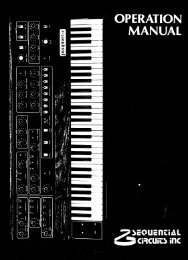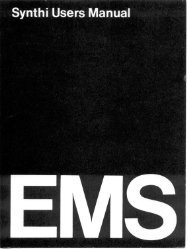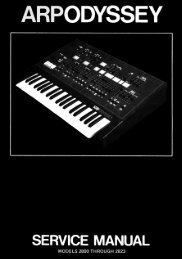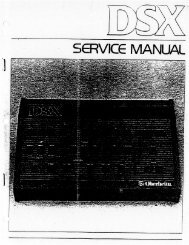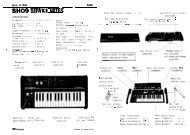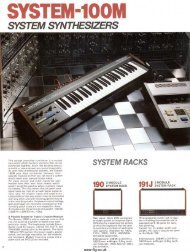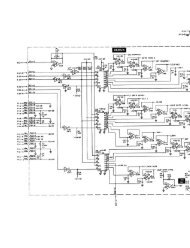ARP2600 - Fundamentals of Music Technology - Cyborgstudio.com
ARP2600 - Fundamentals of Music Technology - Cyborgstudio.com
ARP2600 - Fundamentals of Music Technology - Cyborgstudio.com
You also want an ePaper? Increase the reach of your titles
YUMPU automatically turns print PDFs into web optimized ePapers that Google loves.
038 - SECTION FIVE: NOISE GENERATORThere are five (possibly six) parameters to this patch, just as in the FM patch explained in Section 3.First, the noise generator’s level can be set (this is effectively the same as parameter 3 in which themodulation depth is set). Secondly, the noise generator’s frequency attenuation slider can be set whichdetermines how many upper harmonics will be added to VCO-3’s output. Third, the level <strong>of</strong> modulationcan be set using the attenuation slider above the FM input (master-submaster relationship withparameter 1.) Fourth, the frequency <strong>of</strong> VCO-3 can be set. Fifth, the timbre <strong>of</strong> VCO-3 can be set. Sixth,when VCO-3’s pulse output is used, its pulse width can be set.THE NOISE GENERATOR IN PWMNoise GeneratorFreq LevelOutputPWM InputVCO-2PulseWaveOutputNFigure 5-3: The noise generator in PWMAnother excellent possibilityfor use <strong>of</strong> the noisegenerator is using it tochange the pulse width orduty cycle <strong>of</strong> the pulsewave output on VCO-2.The output <strong>of</strong> the noisegenerator could be manuallypatched to the PWMinput on VCO-2, butcloser inspection <strong>of</strong> thisinput will reveal somethingimportant: the noisegenerator is normalled to the PWM input. This is important to note, since normals represent the waythings are most <strong>com</strong>monly patched together. Thus, patching the noise generator’s output to the PWMinput must be a fairly <strong>com</strong>mon application.Once again, the noise generator is the modulator in this patch, and VCO-2 is the carrier. This patch hasfour possible parameters: First, the noise generator’s level can be set. This will effectively do the samething as the attenuation at the PWM input. Second, the noise generator’s frequency slider can be set totailor the noise. This will determine the level <strong>of</strong> the higher harmonics in the pulse waveform that VCO-2 will produce. Third, the depth <strong>of</strong> modulation can be attenuated by the slider above the PWM input.This effectively does the same thing as the first parameter.Similarly to the FM patch illustrated earlier, the noisegenerator’s level has been set to full open, and its level hasbeen attenuated at VCO-2’s PWM input. Finally, VCO-2’sfrequency can be set. (One might think that VCO-2’s timbrecould be a fifth parameter in this patch, but this is not so; thepulse wave must be used if one is attempting pulse widthmodulation.) Notice that parameter 1 (the noise generator’slevel) and parameter 3 (modulation depth) have a mastersubmasterrelationship. The parameters <strong>of</strong> the patch illustratedin 5-3 are summarized in Figure 5-4.To amplifierand speakers1. Noise generator’s level2. Noise generator’s frequency3. Depth <strong>of</strong> PWM modulation(effectively same as #1)4. VCO-2’s frequencyFigure 5-4: Parameters <strong>of</strong> a PWMpatch using the noise generator




